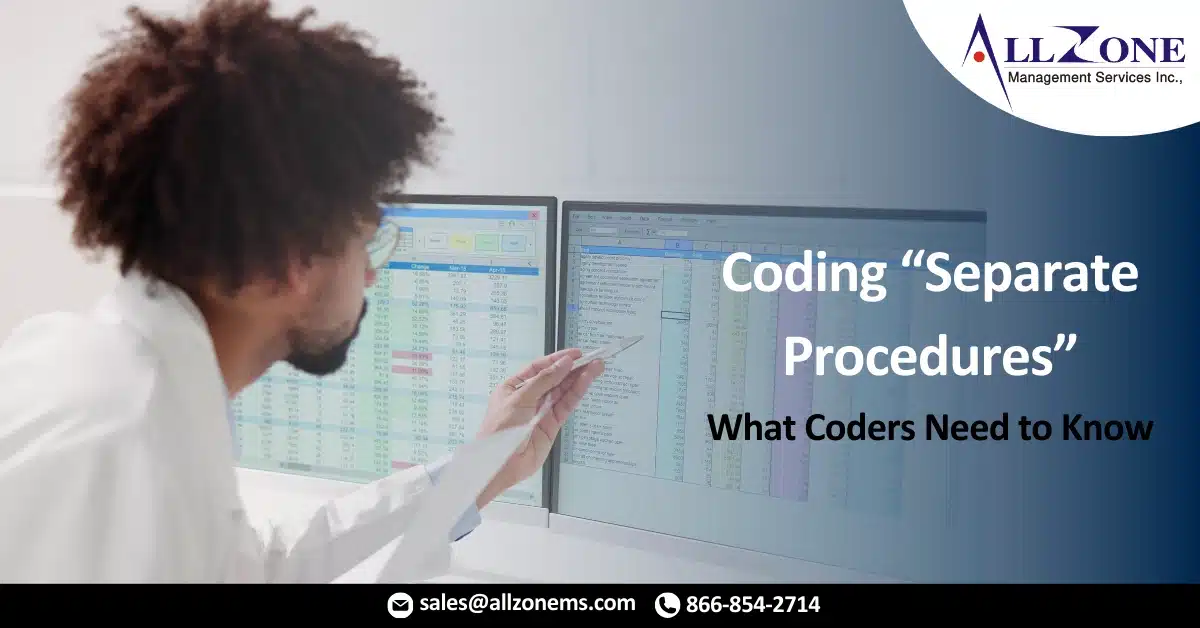“Separate procedure” may not mean what you think.
Many procedural codes in the CPT® Book are designated as “separate procedures.” However, the common misinterpretation of this is that coders can report such codes as such in every case.
Not true.
First, you must consider:
- Were there other procedures performed during the same encounter?
- Did you consult the NCCI edits?
- Did the other procedures coded at the same encounter “include” the base code?
You can always identify a designated “separate procedure” by the parenthetical inclusion of (separate procedure) at the end of a CPT code description (e.g. 29870 Arthroscopy, knee, diagnostic, with or without synovial biopsy (separate procedure)). A separate procedure designation identifies a procedure that may be performed independently or as part of a more extensive procedure, depending on the circumstances.
CPT® Surgery Guidelines State:
Some of the procedures or services listed in the CPT® codebook that are commonly carried out as an integral component of a total service or procedure have been identified by the inclusion of term “separate procedure.” The codes designated as “separate procedure” should not be reported in addition to the code for the total procedure or service of which it is considered an integral component.
In lay terms, this means:
- If a separate procedure is performed during a more extensive procedure in which it is typically included, it is not separately reported.
- If a “separate procedure” is performed alone, or with another procedure of which it typically is not a part, it may be separately reported.
For example, 29870 may be reported by itself to describe a diagnostic scope of the knee, but is not separately reported – or reimbursed – with another arthroscopic procedure in the same knee (e.g. 29882 Arthroscopy, knee, diagnostic, with meniscus repair (medial OR lateral))
Because CPT doesn’t provide a complete list of codes to which a “separate procedure” may be bundled, and unless you have a full clinical understanding of the procedure performed, how can you know for certain whether a separate procedure is truly separate?
First, consult the National Correct Coding Initiative (NCCI) edits to determine if a designated separate procedure triggers any NCCI edits. Several encoder products have NCCI lookup tools, as well as your billing software. Check this out with your practice management software vendor. Medicare (Centers for Medicare & Medicaid Services/CMS) updates NCCI edits at the start of each quarter. Always use the most up-to-date version of the NCCI when checking for edits. Also, check your commercial payors to determine if they follow these edits.
Now, remember that these edits aren’t absolute. Even if a designated separate procedure triggers an NCCI edit, you may still be able to report the service separately if:
- The NCCI code pair edit includes a “1” modifier indicator, you may be able to code for it in addition to the primary procedure, based on the circumstances. Codes with a “0” modifier indicator may never be reported separately. Codes assigned a “1” modifier indicator may be reported and reimbursed separately from the column 1 code, if the second condition is also met.
- The separate procedure may be truly separate, and that condition is identified by adding the -59 modifier Distinct procedural service to the designated separate procedure code.
The CPT® Surgery Guidelines Also State:
“However, when a procedure or service that is designated as a ‘separate procedure’ is carried out independently or considered to be unrelated or distinct from other procedures/services provided at the time, it may be reported by itself, or in addition to other procedures/services by appending modifier 59 to the specific ‘separate procedure’ code to indicate that the procedure is not considered to be a component of another procedure, but is distinct, independent procedure or surgery, different site or organ system, separate incision/excision, separate lesion, or separate injury (or area of injury in extensive injury).”
So, for instance, if you check the most recent version of the NCCI edits, you will see that 29870 is bundled into 29882, which is a more extensive service, but a modifier allows (the code pair edit includes a “1” modifier indicator) you to override the edit and report the diagnostic scope separately, under the right circumstances. For example, if the diagnostic scope and the surgical scope procedure were performed in separate knees, 29870 may be billed separately with modifier -59 appended because it represents a separate anatomical location. You could also apply the appropriate LT left side and RT right side modifiers to both the 29870 and 29882 to designate which procedure occurred on which knee.
Rules and Guidelines exist for a reason: to guide us to the correct and compliant way of doing things. There are exceptions to the rules and knowing when to exercise those exceptions is what due diligence is for.
For More Information: https://www.icd10monitor.com/coding-separate-procedures-what-coders-need-to-know

